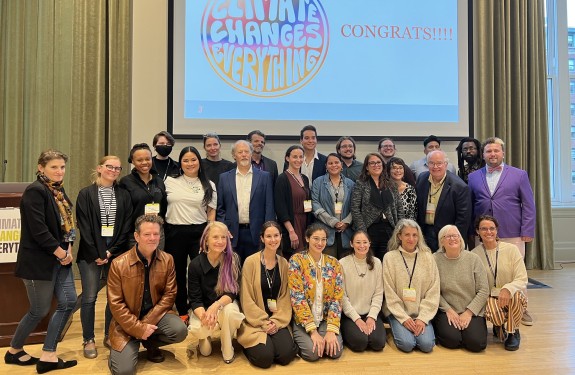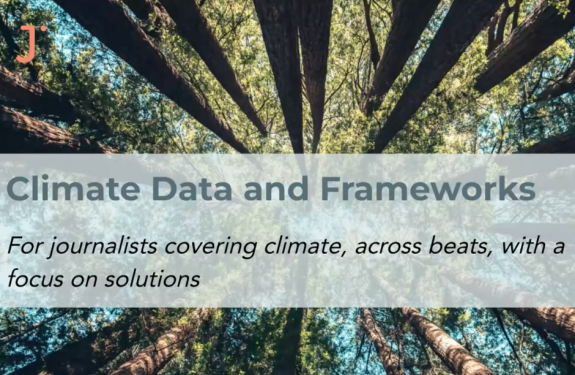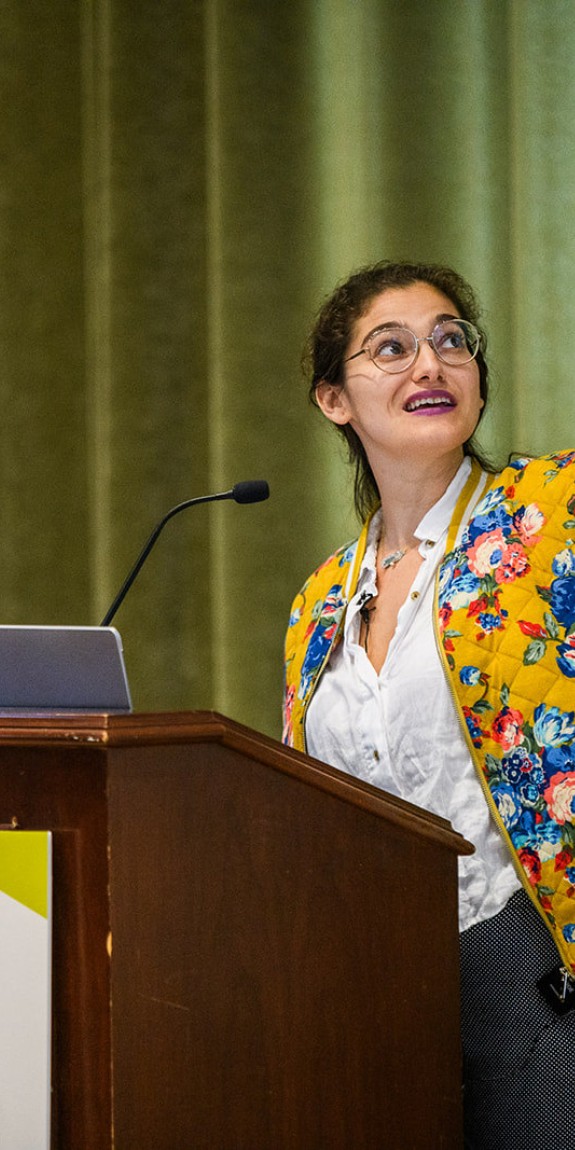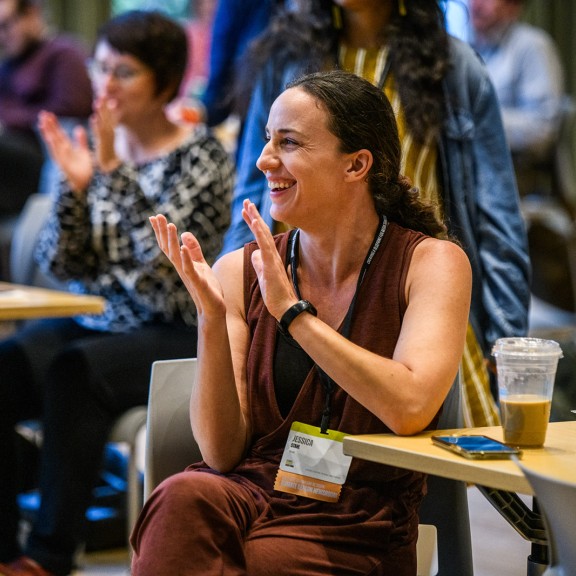Climate
Journalists and newsrooms are producing community-informed, equity-focused climate solutions journalism. Twenty fellows participated in the Climate Solutions Cohort, and nine newsrooms joined the Climate Beacon Newsroom Initiative. We launched the Climate Peer Network and created resources to deepen collaboration around this timely topic.
Pictured above and throughout this page: Journalists and media leaders participate in the Climate Changes Everything conference in New York City in September 2023.

Climate Solutions Fellows
As the global climate crisis intensifies, journalists are increasingly being challenged to broaden and deepen their coverage of it. This includes a renewed effort to focus on groups whose stories have historically been underreported. Twenty fellows from across the nation participated in SJN’s 2023 Climate Solutions Cohort, honing their expertise in climate-focused solutions journalism and engaging in new ways with communities they cover. Individually and collectively, these journalists worked toward building trust and partnering with their audiences throughout the reporting process.
SJN collaborated with Public News Service to produce and disseminate 100 climate-focused solutions stories for its public radio partners, many of them in areas of the country that are underserved by the media or in “news deserts.” The collection included stories produced by the fellows and by SJN partner news organizations. Twenty new fellows will be selected to participate in the 2024 cohort. Tips and Insights for Climate Solutions Practice, which captures the learning from this cohort, will be updated annually.
The Story that Inspired Ecuador's Tourism Minister
Reporter Gabriela Barzallo wrote a solutions story in June 2023 titled “¿Puede la bioeconomía tomar el relevo al petróleo en la Amazonia ecuatoriana?” (“Can the bioeconomy replace oil extraction in the Ecuadorian Amazon?”) for the Americas section of El País, a widely distributed Spanish-language outlet.
The piece caught the attention of Ecuador’s minister of tourism, Niels Olsen, who reached out to Barzallo to discuss ecotourism and other nonextractive economic practices she explored in her article. Six months later, when Olsen outlined the country’s tourism plan, he specifically mentioned sustainable and entrepreneurial forms of tourism that would benefit rural and Indigenous communities.
Climate Beacon Newsrooms
SJN’s 2023 Climate Beacon Newsrooms Initiative provided more than two dozen journalists from nine newsrooms with 10 months of rigorous equity-focused, community-informed solutions reporting training centered on the climate crisis. SJN enlisted its partners Covering Climate Now, Climate Central and Project Drawdown as expert consultants in developing the trainings, providing story development resources and sharing the stories with their networks.
SJN created a Story Map to capture the geographic range and scope of the journalism that emerged. Participating newsrooms each designated a Climate Lead to complete SJN’s Train-the-Trainers program, enabling them to educate their newsrooms in solutions journalism and to serve as ambassadors for the practice. Each newsroom selected a story for distribution through the Public News Service radio network, reaching millions of listeners. In partnership with Covering Climate Now, we published SJN’s first Climate Solutions Reporting Guide and Tips and Insights for Climate Solutions Practice.
WSHU Changed the Conversation and Grew Its Audience
In April 2023, public radio station WSHU launched "Trash Talkin'," a series tackling waste issues affecting Long Island. Front and center was the planned closure of a local landfill, a repository for a massive amount of debris and also a source of pollution. The station sought input from the community at monthly in-person meetings, as well as from its live blog, website and Facebook page. This input informed Freedom of Information Act requests as well as stories focused on solutions.
WSHU’s commitment to a solutions-oriented approach grounded in rigor and community engagement has led to a growing new audience and is being replicated across other projects pursued by the local NPR affiliate.
Covering climate change through a solutions lens is picking up steam. It is not about telling positive, pat-on-the-back stories about climate. The solutions journalism model uses investigative techniques and data that rely on scrupulous reporting to identify policies and practices to help mitigate the crisis.

Climate Changes Everything
During Climate Week in September, SJN partnered with Covering Climate Now (CCN), The Nation, The Guardian and the Columbia Journalism Review to host 400 journalists for “Climate Changes Everything: Creating a Blueprint for Media Transformation.” Journalists shared insights, challenges and best practices emerging from efforts to report on climate change in ways that drive attention and impact while also highlighting solutions and justice. The two-day event in New York City included speakers from news outlets around the world, case study presentations and interviews with experts in climate justice, editorial collaborations, meteorology and fossil fuel advertising.
Just as important were the connections forged during the conference. One attendee said: “The participatory nature of ‘Climate Changes Everything’ was refreshing and invigorating. It gave me hope for the survival of both humans and our humanity.” SJN is now working with CCN and select climate journalists to publish insights from the conference as a “Blueprint for Media Transformation” microsite that will go live in 2024.
Almost every editor featured in this [climate journalism] report tells us that journalism that works for their audiences focuses on solutions, not just the problems.
Climate Resources

Peer Network
In response to the needs of our growing community of climate solutions journalists, SJN launched the Climate Peer Network. This facilitated network enables journalists to share best practices and learn from one another, as well as from experts on topics of shared interest.
Monthly conversations average 125 participants from around the world and include small-group breakouts to develop relationships with like-minded peers covering climate issues. These convenings are nurturing a networked, supportive community for freelancers and staff reporters alike. As one attendee recently wrote: “SJN plays a convener role that is fostering valuable interactions (which, by the way, could not be possible without their support).”

Primer Series
"Holding Companies Accountable," "The Power and Pitfalls of Carbon Dioxide Removal" and "Nature-Based Carbon Removal Methods" were the topics covered in a series of SJN climate webinars moderated by Aman Azhar of Inside Climate News. Scientists and policy experts provided analysis and insights into primary greenhouse gas emissions and technologies to remove, sequester and store carbon dioxide, as well as guidance on how journalists can effectively apply a solutions lens to their reporting on these topics. A fourth webinar, "Climate Data and Frameworks," featured Jonathan Foley of Project Drawdown and Bernadette Woods Placky of Climate Central. The Climate Primer series is available online and will expand with new sessions in 2024.

Climate Solutions Reporting Guide
In partnership with Covering Climate Now, SJN published its first Climate Solutions Reporting Guide, providing journalists with a bird’s-eye view of climate solutions across all beats. We also published Tips and Insights for Climate Solutions Practice, capturing what the 20 journalists in our inaugural Climate Solutions Cohort learned about centering community and equity in their solutions-focused climate reporting. The guide will be updated annually. The breadth and diversity of lessons learned by the nine newsrooms in our inaugural Climate Beacon Newsrooms Initiative are similarly reflected in a series of teaching modules. For example, this module, created by Emilie Stigliani of The Sacramento Bee, takes the user through the process of engaging a community in covering climate across beats and through the lens of solutions.
A Solutions Podcast Becomes Course Material
In spring 2023, University of Kansas Professor Shannon O’Lear launched the course “Geographic Adventures in Climate Change” with the help of three star students who’d admitted to not reading the textbook in her previous class. In this course, the “textbook” was the solutions-focused podcast “The Sweaty Penguin,” which aimed to “cut through the noise and the doom-and-gloom of the climate conversation with late-night-comedy-style monologues and in-depth conversations with leading global experts on a variety of environmental issues."
On its first run, student response was so enthusiastic that one of the course developers, “The Sweaty Penguin” associate producer Emma Jones, was asked to create similar courses around the country. “The Sweaty Penguin” founder Ethan Brown is now leading efforts to build further course curricula from the podcast.
[Solutions journalism] gives me a sense of esteem for humans, and how the negative impacts we have on the environment can be counteracted by the positive actions we engage in.

